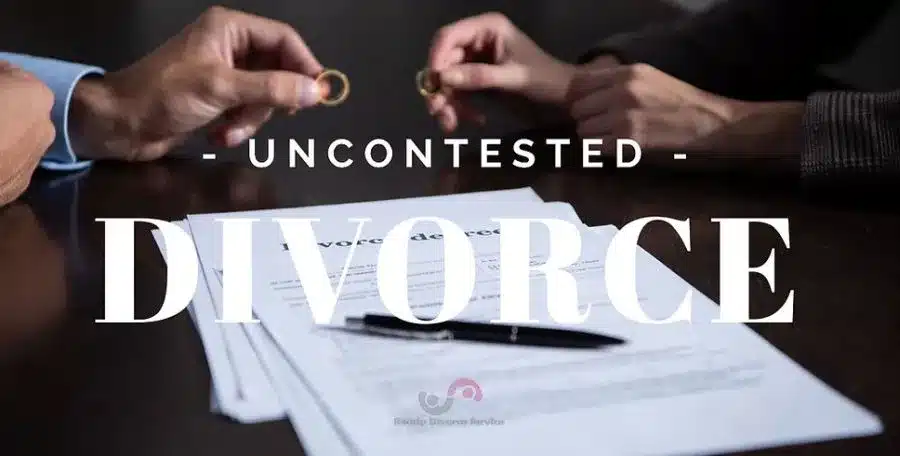The basic divorce process in Texas involves filing a petition with the court, serving your spouse with the papers, exchanging information and negotiating a settlement, attending mediation, and attending a court hearing. A final divorce decree is issued once all issues are resolved.
- Step 1: Preparing for Divorce
- Step 2: Establishing Your Grounds for Divorce
- Step 3: Filing Divorce Papers with a Corresponding Court
- Step 4: Serving Spouse with Divorce Papers
- Step 5: Waiting Period for Divorce in Texas
- Step 6: Getting Divorce Temporary Orders
- Step 7: Drafting a Divorce Settlement Agreement
- Step 8: Attending a Final Divorce Hearing in Court
- Step 9: Obtaining Final Decree of Divorce
- Frequently Asked Questions
This step-by-step divorce process is generalized and varies on a case-by-case basis. You may not need a separate settlement agreement or mediation in an uncontested, agreed-upon divorce. In a disputed contested case, however, you may have multiple hearings and additional processes to go through.

At first, you may be shocked and perplexed by all the things you need to do to end your marriage. How does divorce work in Texas, and how long does it take? What to consider when going through each stage of the process? Let’s review the steps to getting a divorce in Texas in detail to get the answers.
Step 1: Preparing for Divorce
One of the first steps to getting a divorce is ensuring you meet the requirements to start a divorce process in Texas. It means that you already know what kind of case you are going to file for (contested or uncontested), where the court you need to file the papers in is located, what documents you need, etc.
You also need to make sure that you meet the residency requirements. According to state laws, you or your ex should have been residents in the county where you plan to file for 3 months or more. Also, before you file divorce in Texas, you or your spouse must live in the state for 6 months.
Additionally, whether or not you are still living with your ex, you need to change passwords and save important documents to be sure that your information is secure. As long as you’ve made sure that you are on the safe side, you can begin preparing divorce papers. This step seems challenging for many people who are filing for divorce on their own. If you realize that you cannot cope with the form preparation, you can always work with an online divorce service.
Step 2: Establishing Your Grounds for Divorce
Grounds are legally recognized reasons to end a marriage. In order to file for marriage dissolution, the plaintiff (i.e., the filing party) needs to claim one of the 3 no-fault and 4 fault-based grounds for divorce in Texas. Each of them may influence the course and outcome of the marriage dissolution process. For example, if such wrongdoing as adultery was proved, the judge may finalize their decision on divorce, property division, and alimony in favor of the affected party.
The reasons for divorce in Texas include:
- Living apart for at least 3 years
- Insupportability (no-fault option)
- Abandonment for at least 1 year
- Adultery
- Cruel treatment
- Felony convictions
- Confinement in a mental hospital
Step 3: Filing Divorce Papers with a Corresponding Court
If you are not hiring a lawyer, you should understand how to properly file your own divorce. It’s encouraged only in cases where you are in full agreement with your spouse, getting a no-fault, uncontested marriage dissolution. For starters, you need to bring the initial set of papers to the district court of the county where either you or your spouse resides. The clerk will give you back the copies.
Besides, the state also allows petitioners to file electronically. If this option is more convenient for you, you can do it via EFileTexasCourts official website. After passing the registration and filling in the required information, you can start filing. Please note that you may need to pay a service fee.
Generally, when getting а divorce in Texas, you must pay the court fee of about $350, along with additional fees that apply in your case. If you are not able to cover the costs, you can ask the court for a fee waiver. You will need to file an Affidavit of Inability to Pay Court Costs and be ready to prove that your financial situation is dire enough based on local legal standards.
Step 4: Serving Spouse with Divorce Papers
As soon as you are done with filing, you will have to serve the copies of the papers you initially filed on your spouse. If you file for an agreed divorce in Texas, your spouse may agree to waive the service by filing the respective form. Otherwise, the process of service is a must.
According to Rule of Civil Procedure 103, only a sheriff, constable, or professional process server has the right of serving divorce papers in Texas personally to your spouse. Alternatively, you may send the paperwork via certified mail. Your spouse must provide the answer to these papers and send it back to you. If you are not in touch with your spouse or do not know where you can find them, you should find out how to serve divorce papers if you cannot locate your spouse.
Step 5: Waiting Period for Divorce in Texas
After serving court papers in Texas, you will need to wait for some time until your case can be finalized. What is the waiting period for divorce in Texas, and why is it needed? These are 2 months that the state sets aside for the couple to potentially reconcile and withdraw the petition.
Unfortunately, the court cannot proceed with your case if the 60-day waiting period for divorce in Texas is not over. This may only be possible in certain family violence cases. Moreover, you may not get the final hearing right after this period is over if the court is busy. Overall, the average time to get a divorce is 3-6 months. This time will be enough for you to complete the initial disclosure – a step where you and your spouse exchange your financial information.
Step 6: Getting Divorce Temporary Orders
Getting temporary orders is not a mandatory point if your divorce is uncontested. If you have certain disputes with your spouse, your family situation is generally serious, or you have children, you need to know how to act to protect your or your children’s interests while your divorce is not granted.
You may need to obtain divorce temporary orders for divorce in Texas to:
- Determine where your children will reside until the divorce is finalized.
- Decide who will have to move out from the family house.
- Appoint a child support payor and decide who will have legal custody while the case is still in progress.
- Determine whether your spouse must pay temporary alimony during the proceedings.
- Ask the court to issue an order that will restrain the second party from doing certain actions.
Step 7: Drafting a Divorce Settlement Agreement
Making a divorce settlement agreement is an important step for couples who seek to end their marriage amicably. All the conditions you agree upon will be recorded in the divorce settlement agreement form drafted by a lawyer. If you have known from the get-go that your divorce is uncontested, your agreements will likely already be included in other forms, and you won’t require a settlement agreement.
Generally, you and your spouse will have to reach a consensus on:
- How to split your assets and debts
- How to divide your property (since there is no separate divorce property settlement agreement in Texas)
- Where and with whom your children will live, and how you can split the parenting time
- Who gets the custody, and who pays child support
- Whether there is a need to pay spousal support
This document will be provided to the court for review. The judge will check that the terms recorded in the agreement are fair to all the parties, including children, and approve it if all is good.
Step 8: Attending a Final Divorce Hearing in Court
As soon as the waiting period is over, contact the court clerk to schedule the final hearing date. What to expect in your final divorce hearing on your trial day in Texas? If your case is uncontested and you have all your paperwork in order, the hearing won’t take long. You will have to answer a few questions from the judge, and after that, they will grant you a divorce.
If your dissolution of marriage is contested, the hearing will take more time. You may also need to involve the witnesses or experts, such as real estate appraisers or a custody evaluator, to present their findings in court. The judge will then make the final decision, or another hearing might be required if things take a turn. Spouses generally have lawyers in contested cases, so they will be responsible for guiding you through the process.
Step 9: Obtaining Final Decree of Divorce
A final decree of divorce in Texas is a document that finalizes your marriage dissolution. All the conditions of the marital settlement agreement will be included in this paper. During your initial steps, you have to fill out a final divorce decree and submit it to the court together with other documents before the hearing.
After the form is signed by the judge, it is then filed with the court clerk. You can obtain a copy of a decree in the clerk’s office in the court where your case was finalized. Please note that you will need to pay the fee for this copy.
Frequently Asked Questions
You will need to reach a full agreement with your spouse concerning the division of assets and property, child custody/support payments, and so on. After that, you need to complete the paperwork, file it with the court, service the copies on your spouse, and file the answer or waiver. Finally, you should complete initial disclosures and schedule a final hearing after your waiting period is over.
You will have to file for marriage dissolution in a district court of the county where you or your spouse resides.
Usually, no. It may be possible in a full-agreement uncontested case if you are allowed to file the Affidavit for Prove-Up. This form is used by those who cannot be present at the hearing for some reason. If this form is accepted, you can avoid going to court.






Cool Stuff